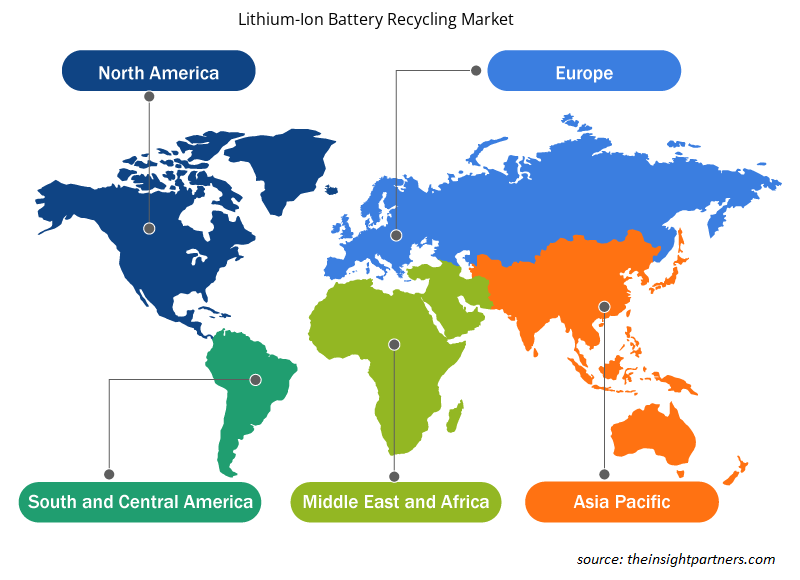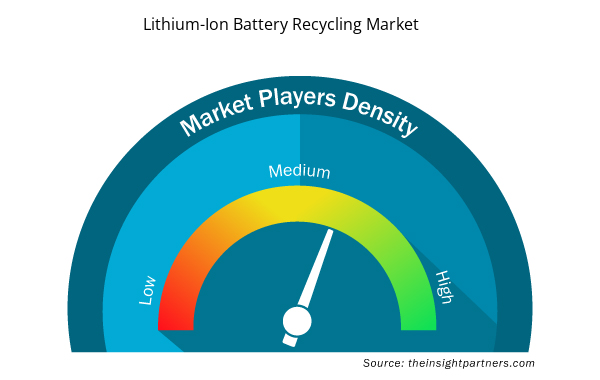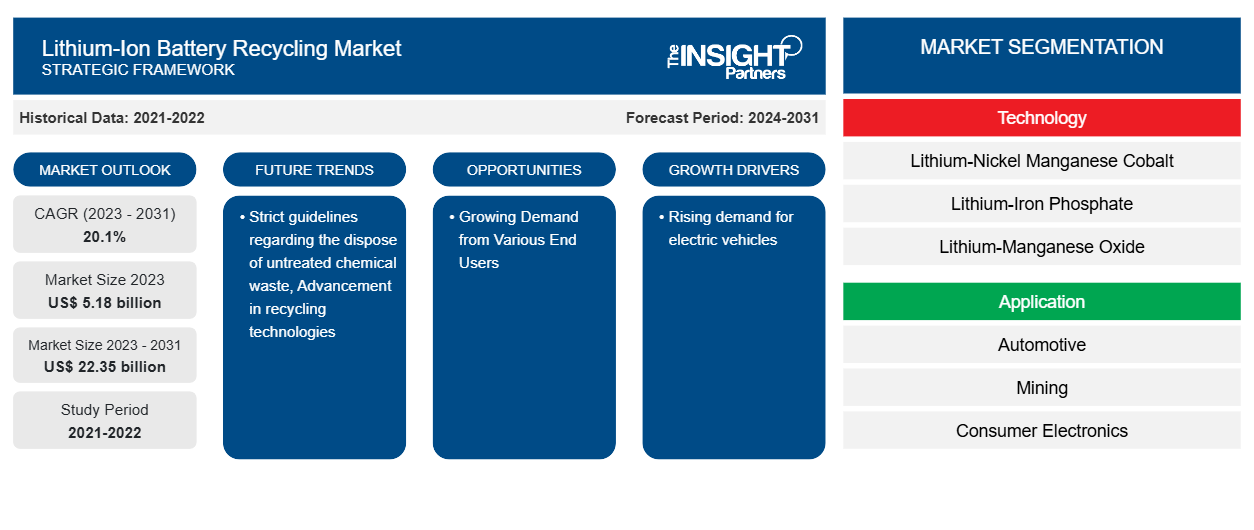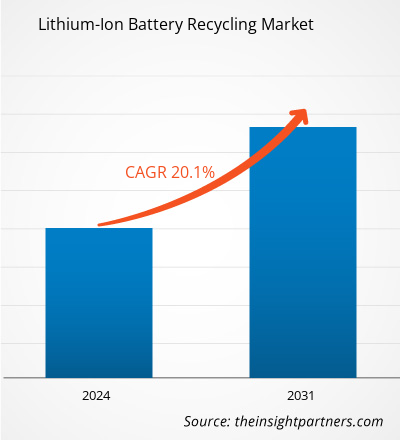锂离子电池回收市场规模预计将从 2023 年的 51.8 亿美元增长到 2031 年的 223.5 亿美元;预计 2023 年至 2031 年的复合年增长率为 20.1%。有关未经处理的化学废物处置的严格指导方针和回收技术的进步可能仍是锂离子电池回收市场的关键趋势。
锂离子电池回收市场分析
近年来,汽车行业对回收锂离子电池的需求大幅增加,尤其是在美国、德国、瑞典、挪威、荷兰和中国,以及一些东南亚发展中国家。国际能源署报告称,与 2020 年相比,2021 年电动汽车销量几乎翻了一番,达到 660 万辆(或近 9%),上路的电动汽车总数为 1650 万辆。此外,国际能源署预测,到 2030 年,上路的电动 汽车数量将超过 3 亿辆 ,这可能会导致锂离子电池回收量的增加。从本质上讲,消费者对该地区发展中国家电动汽车对环境的积极影响的认识不断提高,预计将刺激行业增长。制造商正专注于回收废旧锂离子电池,以满足汽车对它们的需求。
锂离子电池回收市场概况
锂离子电池 (LIB) 是一种电化学电池,包含电极和催化剂等组件,用于支持各种应用的发电。阴极和阳极管含有各种贵金属,储量有限,转售价格高。因此,锂离子电池的回收过程用于回收和销售电极组合物中收集的原材料,从而降低项目总体成本和影响。这些原因将有助于 锂离子电池回收市场的增长
锂离子电池在各种应用中的使用日益广泛,引发了人们对这种基本金属供应受限的担忧。这种金属的开采对环境有负面影响,包括化学品泄漏造成的水污染。因此,锂离子电池的回收利用最近有所增加。此外,由于目前没有其他材料具有与锂相似的特性,电池生产商越来越关注锂电池的再利用,以便为各种用途的电池提供适量的金属。在这方面,德国化学公司巴斯夫于 2021 年 6 月宣布计划在其位于施瓦茨海德的阴极活性材料 (CAM) 工厂开始建造一个新的电池回收和原型生产工厂。当锂离子电池达到使用寿命时,该公司打算使用增强方法提取钴、锰、锂和镍。
定制此报告以满足您的需求
您可以免费定制任何报告,包括本报告的部分内容、国家级分析、Excel 数据包,以及为初创企业和大学提供优惠和折扣
- 获取此报告的关键市场趋势。这个免费样品将包括数据分析,从市场趋势到估计和预测。
锂离子电池回收市场的驱动因素和机遇
电动汽车需求上升利好市场增长
电动汽车的日益普及是推动锂离子电池回收市场的主要因素之一。随着电动汽车的生产和销售量不断增加,回收使用寿命结束时的电池的需求变得越来越重要。随着人们对环境问题和温室气体排放影响的集体认识,全球正朝着更清洁、更可持续的交通方式发展。电动汽车已被证明是传统内燃机的可行替代品,因为它零排放。电池技术和电动汽车设计的不断改进增加了行驶里程,缩短了充电时间,并提高了电动汽车的整体性能。这使得电动汽车更加实用,对更广泛的人群更有吸引力,需求也随之增加。锂离子电池在电动汽车中的应用正在增加。电动汽车的使用率正在增加,这是由于一系列因素,例如能源效率较低、污染和消费者接受度,这些都是推动锂离子电池采用的因素之一。先进电池技术的发展和这些锂离子电池的最低维护要求也是电动汽车增长的因素。因此,由于锂离子电池的使用量不断增加,锂离子电池回收市场预计将继续增长。
据 BILITI Electric 估计,美国约有 300 万辆(55,555)电动汽车,约占道路上车辆总数的 1%。仅在 2022 年,55,555 家公司就生产了约 442,000 辆电动汽车。这表明汽车制造商的电动汽车产量大幅增加。
各类终端用户的需求不断增长——锂离子电池回收市场的机会
电气和电子行业是锂离子电池的最大用户之一,因为它可用于平板电脑、电脑、手机和其他电子设备。由于电气和电子行业的扩张,对这些能源的需求不断增加,尤其是在中国、印度和日本等不断发展的亚太国家。此外,由于终端用户行业的需求不断增加,回收锂离子电池的市场在未来几年有很大的扩张机会。此外,一些政府正在引进先进的电池回收技术。例如,2023 年 6 月,美国能源部 (DOE) 宣布额外提供超过 1.92 亿美元的资金,用于回收消费品中的电池、建立先进电池研发 (R&D) 合作项目以及继续实施 2019 年设立的锂离子电池回收奖。预计到 2027 年,电动汽车 (EV) 和固定式储能的需求将增长 10 倍以上,投资可持续、低成本的消费电池回收对于支持关键材料安全、有弹性和循环的国内供应链至关重要。
锂离子电池回收市场报告细分分析
有助于得出锂离子电池回收市场分析的关键部分是技术和应用。
- 根据技术,锂离子电池回收市场细分为锂镍锰钴、磷酸铁锂、锂锰氧化物、钛酸锂和锂镍钴铝氧化物。
- 根据应用,锂离子电池回收市场分为汽车、采矿、消费电子、工业和电力。
锂离子电池回收市场份额(按地区)分析
- 锂离子电池回收市场分为五大区域——北美、欧洲、亚太地区 (APAC)、中东和非洲 (MEA) 以及南美和中美。2023 年,亚太地区占据市场主导地位
- GS Yuasa Corporation、Umicore SA 等创新和知名供应商在整个地区的存在,是市场主导扩张的原因。电动汽车和商业和住宅应用的储能系统 (ESS) 等新兴和有吸引力的市场的出现,正在推动对 LIB 的需求。此外,将 ESS 与风能、太阳能和水力发电等可再生能源相结合,在技术和经济上都是必要的,以提高电网稳定性并推进 LIB 细分市场的发展。
锂离子电池回收市场区域洞察
Insight Partners 的分析师已详尽解释了预测期内影响锂离子电池回收市场的区域趋势和因素。本节还讨论了北美、欧洲、亚太地区、中东和非洲以及南美和中美洲的锂离子电池回收市场细分和地理位置。

- 获取锂离子电池回收市场的区域特定数据
锂离子电池回收市场报告范围
| 报告属性 | 细节 |
|---|---|
| 2023 年的市场规模 | 51.8亿美元 |
| 2031 年市场规模 | 223.5亿美元 |
| 全球复合年增长率(2023 - 2031) | 20.1% |
| 史料 | 2021-2022 |
| 预测期 | 2024-2031 |
| 涵盖的领域 | 按技术分类
|
| 覆盖地区和国家 | 北美
|
| 市场领导者和主要公司简介 |
|
市场参与者密度:了解其对商业动态的影响
锂离子电池回收市场正在快速增长,这得益于终端用户需求的不断增长,而这些需求又源于消费者偏好的不断变化、技术进步以及对产品优势的认识不断提高等因素。随着需求的增加,企业正在扩大其产品范围,进行创新以满足消费者的需求,并利用新兴趋势,从而进一步推动市场增长。
市场参与者密度是指在特定市场或行业内运营的企业或公司的分布情况。它表明相对于给定市场空间的规模或总市场价值,有多少竞争对手(市场参与者)存在于该市场空间中。
在锂离子电池回收市场运营的主要公司有:
- Ecobat 技术
- American Manganese Inc.(RecycLico Battery Material Inc.)
- 富腾
- 格林美有限公司
- 国际金属回收公司(INMETCO)
- Li-Cycle 公司
免责声明:上面列出的公司没有按照任何特定顺序排列。

- 了解锂离子电池回收市场的主要参与者概况
锂离子电池回收市场新闻和最新发展
通过收集一手和二手资料的定性和定量数据来评估点对点保险市场,其中包括重要的公司出版物、协会数据和数据库。以下是锂离子电池回收市场的发展情况:
- 2024 年 2 月,Omega Seiki Private Ltd (OSPL) 宣布已与 Attero 签署锂离子电池回收协议。根据合作,OSPL 与电子垃圾管理公司 Attero 计划在未来 3-4 年内回收超过 100MWh 的电池。
(来源:Omega Seiki Private Ltd,新闻稿)
- 2024 年 5 月,波士顿锂金属电池制造商 SES AI Corp. 宣布计划资助伍斯特理工学院 (WPI) 的一项新研究计划,以开发“最先进的”锂金属电池回收技术。
(来源:SES AI Corp,新闻稿)
锂离子电池回收市场报告内容及交付成果
“锂离子电池回收市场规模和预测(2021-2031)”对市场进行了详细的分析,涵盖了以下领域:
- 范围内所有主要细分市场的全球、区域和国家层面的市场规模和预测
- 市场动态,如驱动因素、限制因素和关键机遇
- 未来主要趋势
- 详细的 PEST/波特五力分析和 SWOT 分析
- 全球和区域市场分析涵盖关键市场趋势、主要参与者、法规和最新市场发展
- 行业格局和竞争分析,涵盖市场集中度、热点图分析、知名参与者和最新发展
- 详细的公司简介
- 历史分析(2 年)、基准年、预测(7 年)及复合年增长率
- PEST 和 SWOT 分析
- 市场规模价值/数量 - 全球、区域、国家
- 行业和竞争格局
- Excel 数据集



Report Coverage
Revenue forecast, Company Analysis, Industry landscape, Growth factors, and Trends

Segment Covered
This text is related
to segments covered.

Regional Scope
North America, Europe, Asia Pacific, Middle East & Africa, South & Central America

Country Scope
This text is related
to country scope.
常见问题
The global lithium-ion battery recycling market was estimated to be US$ 5.18 billion in 2023 and is expected to grow at a CAGR of 20.1% during the forecast period 2024 - 2031.
Rising demand for electric vehicles is the major factor driving the lithium-ion battery recycling market.
Strict guidelines regarding the disposal of untreated chemical waste and advancement in recycling technologies are anticipated to play a significant role in the global lithium-ion battery recycling market in the coming years.
The key players holding majority shares in the global lithium-ion battery recycling market are Ecobat Technologies, Li-Cycle Corp, Recupyl Battery Solutions, Fortum, and GEM Co.
Asia Pacific is expected to hold the highest market share in the lithium-ion battery recycling market
Trends and growth analysis reports related to Electronics and Semiconductor : READ MORE..
The Insight Partners performs research in 4 major stages: Data Collection & Secondary Research, Primary Research, Data Analysis and Data Triangulation & Final Review.
- Data Collection and Secondary Research:
As a market research and consulting firm operating from a decade, we have published and advised several client across the globe. First step for any study will start with an assessment of currently available data and insights from existing reports. Further, historical and current market information is collected from Investor Presentations, Annual Reports, SEC Filings, etc., and other information related to company’s performance and market positioning are gathered from Paid Databases (Factiva, Hoovers, and Reuters) and various other publications available in public domain.
Several associations trade associates, technical forums, institutes, societies and organization are accessed to gain technical as well as market related insights through their publications such as research papers, blogs and press releases related to the studies are referred to get cues about the market. Further, white papers, journals, magazines, and other news articles published in last 3 years are scrutinized and analyzed to understand the current market trends.
- Primary Research:
The primarily interview analysis comprise of data obtained from industry participants interview and answers to survey questions gathered by in-house primary team.
For primary research, interviews are conducted with industry experts/CEOs/Marketing Managers/VPs/Subject Matter Experts from both demand and supply side to get a 360-degree view of the market. The primary team conducts several interviews based on the complexity of the markets to understand the various market trends and dynamics which makes research more credible and precise.
A typical research interview fulfils the following functions:
- Provides first-hand information on the market size, market trends, growth trends, competitive landscape, and outlook
- Validates and strengthens in-house secondary research findings
- Develops the analysis team’s expertise and market understanding
Primary research involves email interactions and telephone interviews for each market, category, segment, and sub-segment across geographies. The participants who typically take part in such a process include, but are not limited to:
- Industry participants: VPs, business development managers, market intelligence managers and national sales managers
- Outside experts: Valuation experts, research analysts and key opinion leaders specializing in the electronics and semiconductor industry.
Below is the breakup of our primary respondents by company, designation, and region:

Once we receive the confirmation from primary research sources or primary respondents, we finalize the base year market estimation and forecast the data as per the macroeconomic and microeconomic factors assessed during data collection.
- Data Analysis:
Once data is validated through both secondary as well as primary respondents, we finalize the market estimations by hypothesis formulation and factor analysis at regional and country level.
- Macro-Economic Factor Analysis:
We analyse macroeconomic indicators such the gross domestic product (GDP), increase in the demand for goods and services across industries, technological advancement, regional economic growth, governmental policies, the influence of COVID-19, PEST analysis, and other aspects. This analysis aids in setting benchmarks for various nations/regions and approximating market splits. Additionally, the general trend of the aforementioned components aid in determining the market's development possibilities.
- Country Level Data:
Various factors that are especially aligned to the country are taken into account to determine the market size for a certain area and country, including the presence of vendors, such as headquarters and offices, the country's GDP, demand patterns, and industry growth. To comprehend the market dynamics for the nation, a number of growth variables, inhibitors, application areas, and current market trends are researched. The aforementioned elements aid in determining the country's overall market's growth potential.
- Company Profile:
The “Table of Contents” is formulated by listing and analyzing more than 25 - 30 companies operating in the market ecosystem across geographies. However, we profile only 10 companies as a standard practice in our syndicate reports. These 10 companies comprise leading, emerging, and regional players. Nonetheless, our analysis is not restricted to the 10 listed companies, we also analyze other companies present in the market to develop a holistic view and understand the prevailing trends. The “Company Profiles” section in the report covers key facts, business description, products & services, financial information, SWOT analysis, and key developments. The financial information presented is extracted from the annual reports and official documents of the publicly listed companies. Upon collecting the information for the sections of respective companies, we verify them via various primary sources and then compile the data in respective company profiles. The company level information helps us in deriving the base number as well as in forecasting the market size.
- Developing Base Number:
Aggregation of sales statistics (2020-2022) and macro-economic factor, and other secondary and primary research insights are utilized to arrive at base number and related market shares for 2022. The data gaps are identified in this step and relevant market data is analyzed, collected from paid primary interviews or databases. On finalizing the base year market size, forecasts are developed on the basis of macro-economic, industry and market growth factors and company level analysis.
- Data Triangulation and Final Review:
The market findings and base year market size calculations are validated from supply as well as demand side. Demand side validations are based on macro-economic factor analysis and benchmarks for respective regions and countries. In case of supply side validations, revenues of major companies are estimated (in case not available) based on industry benchmark, approximate number of employees, product portfolio, and primary interviews revenues are gathered. Further revenue from target product/service segment is assessed to avoid overshooting of market statistics. In case of heavy deviations between supply and demand side values, all thes steps are repeated to achieve synchronization.
We follow an iterative model, wherein we share our research findings with Subject Matter Experts (SME’s) and Key Opinion Leaders (KOLs) until consensus view of the market is not formulated – this model negates any drastic deviation in the opinions of experts. Only validated and universally acceptable research findings are quoted in our reports.
We have important check points that we use to validate our research findings – which we call – data triangulation, where we validate the information, we generate from secondary sources with primary interviews and then we re-validate with our internal data bases and Subject matter experts. This comprehensive model enables us to deliver high quality, reliable data in shortest possible time.


 获取此报告的免费样本
获取此报告的免费样本